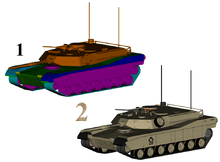Texture
Texture may refer to:
Science and technology
- Texture (roads), road surface characteristics with waves shorter than road roughness
Arts
Music
See also

Texture (painting)
Texture in painting is the look and feel of the canvas. It is based on the paint, and its application, or the addition of materials such as ribbon, metal, wood, lace, leather and sand. The concept of 'painterliness' also has bearing on texture. The texture stimulates two different senses; sight and touch. There are four types of texture in art: actual texture, simulated texture, abstract texture, and invented texture.
Actual texture
This is a combination of how the painting looks, and how it feels to the touch. It is associated both with the heavy buildup of paint, such as an impasto effect, or the addition of materials.
Simulated texture
Creating the visual effect of texture without actually adding texture. For instance, a texture created to look like something other than paint on a flat surface. An example is Cataract 3, painted in 1967 by Bridget Riley, which creates the illusion of ripples in the paper through the repetition of lines.
Implied texture
Texture that does not directly represent the object it is connected with but the concept of the object is translated in textural patterns.

Texture mapping
Texture mapping is a method for adding detail, surface texture (a bitmap or raster image), or color to a computer-generated graphic or 3D model. Its application to 3D graphics was pioneered by Edwin Catmull in 1974.
Originally a method that simply wrapped and mapped pixels from a texture to a 3D surface - now more technically called diffuse mapping to distinguish it from more complex mappings - in recent decades the advent of multi-pass rendering and complex mapping such as height mapping, bump mapping, normal mapping, displacement mapping, reflection mapping, mipmaps, occlusion mapping, and many other complex variations on the technique have made it possible to simulate near-photorealism in real time, by vastly reducing the number of polygons and lighting calculations needed to construct a realistic and functional 3D scene.

